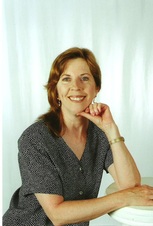In my humble opinion, meditation is a huge part of learning what the Course in Miracles has to offer. Here's a fun article on mediation I wrote for my weekly writer's group. It's light-hearted. Hope you enjoy it.
 Becky. My life partner and fave meditation partner on what life seems to bring us.
Becky. My life partner and fave meditation partner on what life seems to bring us. The question is: Should I weave a clever web of words that gradually lets the reader discover the point I want to make? Or should I explain everything right up front? I'll opt for the latter, more or less.
So here's the point: The noise of air flowing in and out of my nostrils was loud enough to make me think of tornadoes and wind storms. It raged through my nostrils at each in-breath and, especially, at each exhale. From now on I'm going to lay on my belly when I meditate. That's the point of this story.
You see, I was listening to that man with three names. Jon Kabat-Zinn. Doctor. PhD. Founder of the Center for Mindfulness in Medicine at the University of Massachusetts School of Medicine.
He was leading me through a guided mindfulness meditation (get an example here) and told me to pay attention to my breath. The idea is that paying attention to breathing distracts the mind from its usual “monkey chatter” of thoughts that pop up and and never stop running. Most people can't ignore that chatter for more than a few seconds, so focusing on one's breath is a good way to stop the chatter and begin noticing the present moment—which is all any of us ever have or will have. As Eleanor Roosevelt said, “The past is history, the future a mystery, and today is a gift. That's why they call it the present.”
Kabat-Zinn said if I pay attention to my breathing I could find myself mindfully in the present moment. He said I could attend to the sound and feeling of air moving through my nostrils. Or, I might pay attention to the rise and fall of my belly. Or my chest. Whatever, for me, gave me the most vivid sensation of breathing.
I stretched out on my chaise lounge in the Florida sun, listening to my breath as it wafted through my nostrils. But, as Kabat-Zinn pointed out, the mind has an active life of its own. It's inquisitive. It obsesses over ideas. It can carry one's focus and attention to far away places. So far you forget about your breath and about meditating.
Indeed. After a short time my attention got side tracked. Diverted. High jacked. Soon I noticed I was thinking about what I would do later. What I had already done. What I might do. My breath was just too reserved and quiet to keep my attention in the present moment.
A bead of sweat formed on my upper lip as the April sun shone on my face. A droplet rolled down my cheek and the trickle caught my attention. Forgetting my breath altogether, I wiped my face. I turned over on my stomach so the sun wouldn't make my face sweat.
With sunglasses keeping me in darkness against the brilliant sunshine; with iPod headphones on my ears playing Kabat-Zinn's gentle words; and with a ball cap on my head, with the visor re-positioned to keep the sun out of my eyes — I pressed my body and my face into the thick, luxurious cushion of the chaise lounge. But I couldn't find a comfortable place for my nose. No matter how I turned, I couldn't relax without constricting the air flow through my nostrils.
Okay, I thought. This session is about meditation, not distractions. Go with the flow. Get used to it. Forget the problem with my nose. Gradually I relaxed and couldn't help but notice the wind whistling in and out of my nostrils at each breath.
It was a loud, roaring, sibilant whooshing, whistling, hissing sound, especially on the out-breath. Something like the sound of rhythmically ripping cotton bed sheets into thin strips. That cadenced sound roared in my ears like a white noise tornado sucking air molecules in and blowing them back out.
After several minutes I raised my head off the cushion and realized: Hey! I can't hear myself think. Yay! That's what I'm shootin' for.
It seems having no comfortable place to put my nose was just what I needed. So from now on when I meditate I'll try to be more like a dog. They usually lay on their belly. And they never, ever think about breathing.


